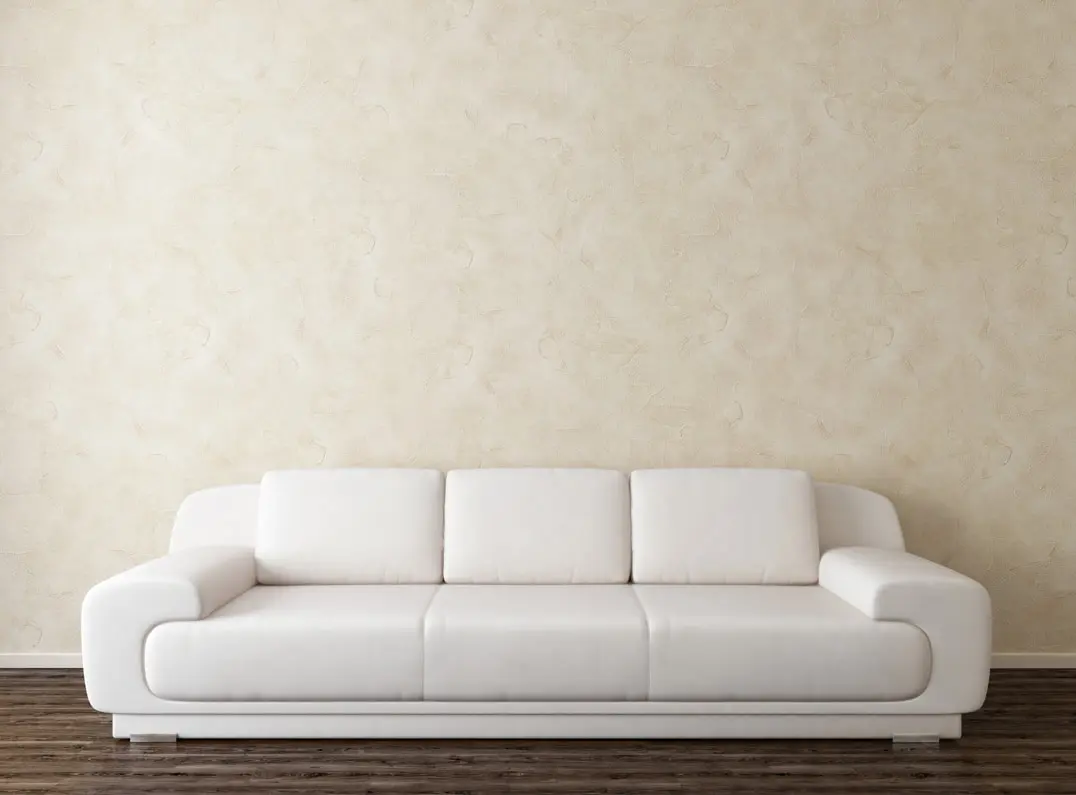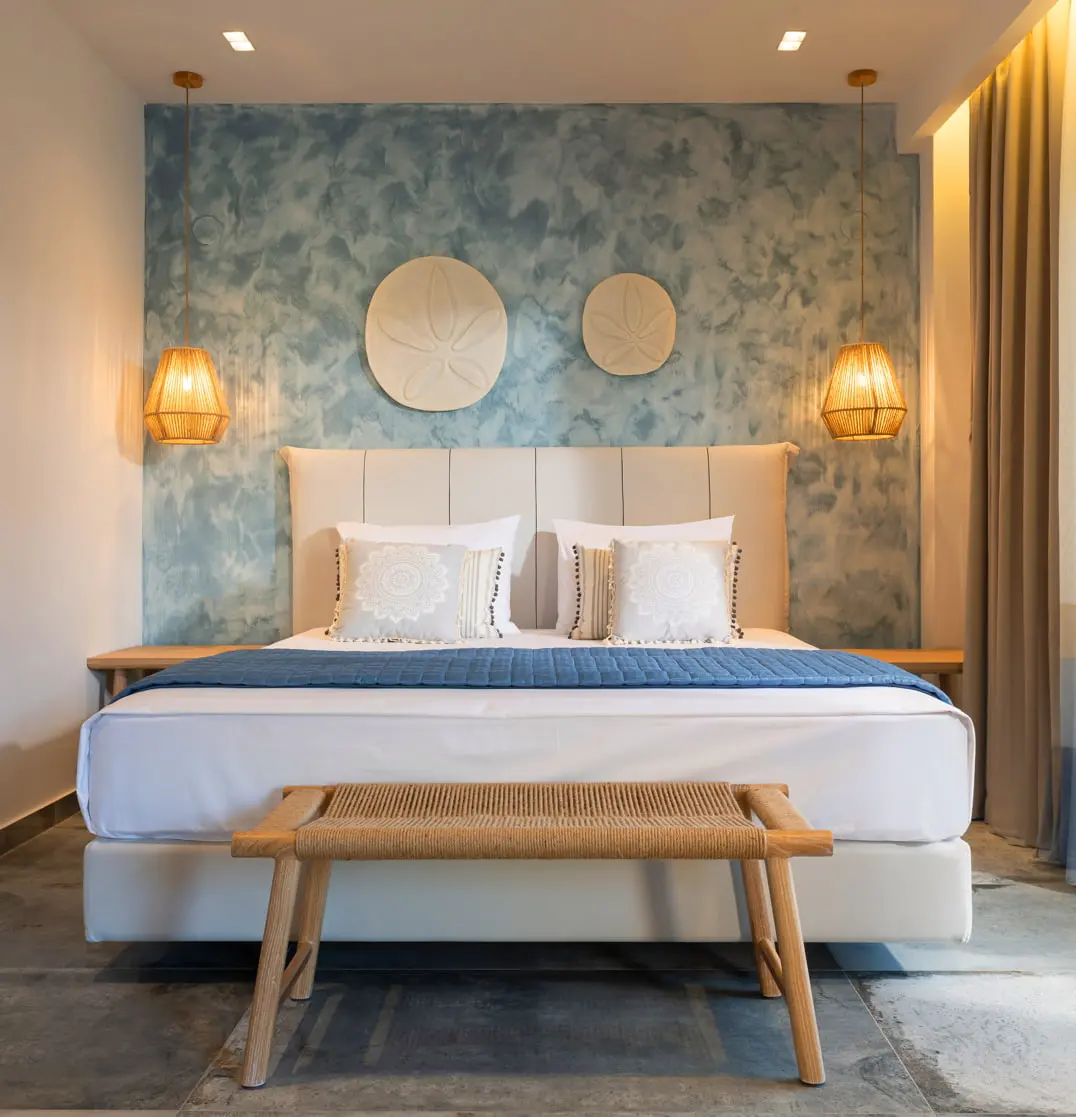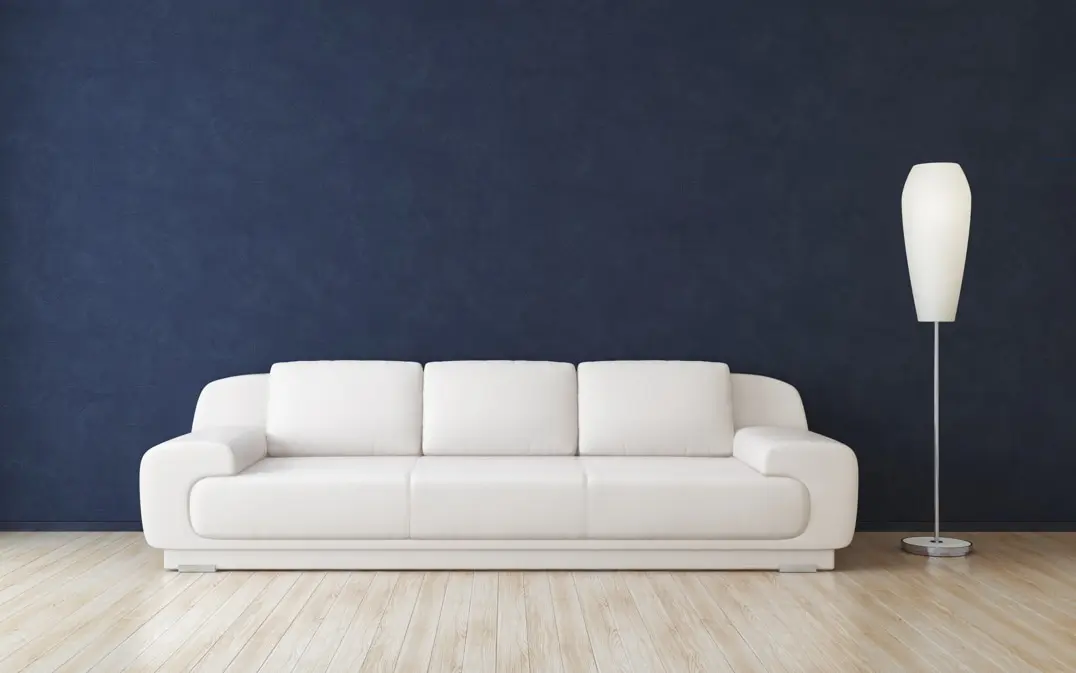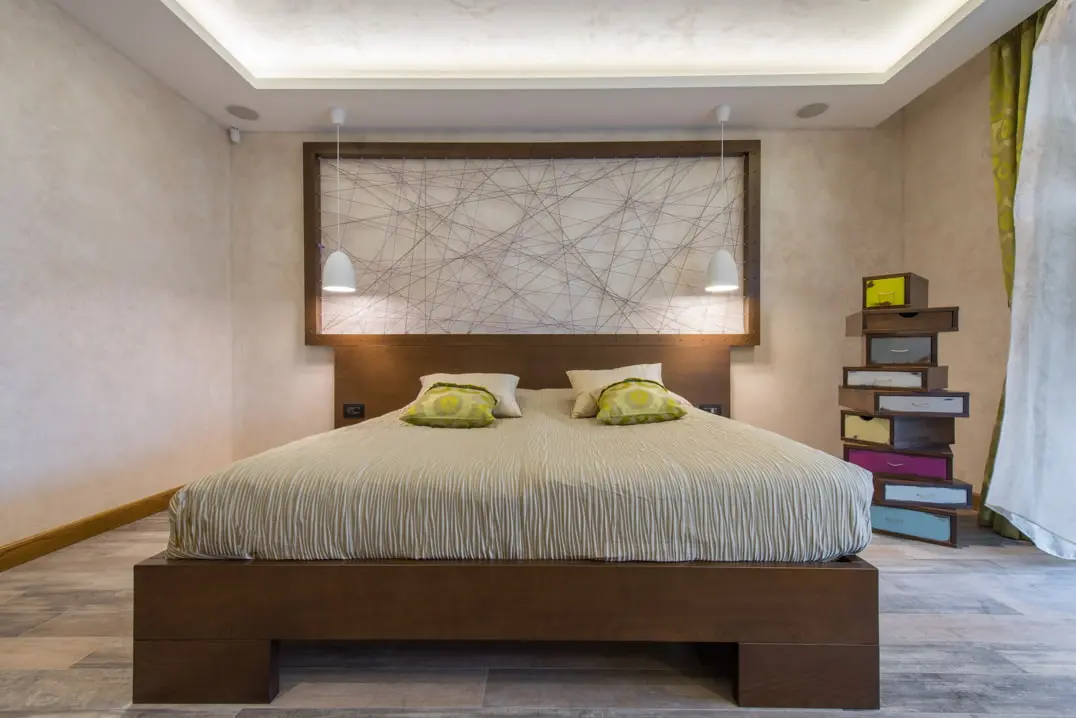The demand in any refurbishment project is increasingly high, so professionals must portray an image of quality and offer a wide range of options to achieve elegant environments. And when thinking about high decoration, we must talk about Venetian stucco.
It's one of the oldest decorative painting techniques whose use dates back to the 15th century, when this material became popular among Venetian architects. Since then its value has only increased, taking into account that the customization of spaces has become highly sought after. The need to offer unique finishes requires understanding various techniques to design inspiring environments.

Application of Venetian stucco on a wall in neutral tones that perfectly complements the leather couch and the wooden floor
Venetian stucco is a wall finishing technique that has been employed for centuries in high-end interior decoration. It is characterized by its luxurious appearance and smooth touch, which are achieved through the application of multiple layers of mortar and colored pigments.
Venetian stucco was given its name because it originated in Venice during the 15th century, the cradle of artists and craftsmen who comprised the Venetian school, so important in the Renaissance movement.
During that era, Venetian stucco was used in the decoration of palaces and religious buildings, and was considered a symbol of wealth and distinction. Since then, Venetian stucco has been used in interior decoration all over the world and has evolved to adapt to current trends and styles.
The mortar used in Venetian stucco is a mix of lime, marble and plaster, which is applied in layers onto the surface of the wall with a spatula. The number of layers needed varies depending on the desired effect, but generally between two and five layers are applied. The application of each layer must be done carefully to ensure a uniform and smooth surface.
The choice of colors and textures of the mortar is crucial in the Venetian stucco technique. Natural or artificial pigments can be used to obtain a wide variety of colors, from the softest and most neutral tones to the most vibrant and bold colors. The final texture of the finish will depend on the amount of pigment and the application technique used.
One of the most important aspects to consider when applying Venetian stucco is the adequate preparation of the wall surface. The wall must be completely clean and smooth before applying the mortar, and any imperfection or irregularity in the surface must be corrected before starting the application.
To apply Venetian stucco, tools such as trowels, spatulas, and palettes are needed to apply the mortar accurately and achieve the desired finish. In addition, it is important to have skill and practice in the technique, as the application of the mortar needs to be done carefully to achieve the desired effect.
- Versatility in decoration.
Venetian stucco is a versatile technique that can be used to create a wide variety of decorative effects. For example, it can be applied in different shades to create a gradient effect or to highlight certain architectural features, such as columns or archways.
It can also be used to mimic the appearance of other materials, such as marble, stone or wood. In addition, Venetian stucco can be applied in different textures, from smooth and shiny surfaces to rougher and matte surfaces.
- Durability.
Venetian stucco is a very durable material, which makes it ideal for use in high traffic areas and where a wear-resistant surface is required.
Additionally, Venetian stucco is water and stain resistant, making it suitable for use in bathrooms, kitchens, and other moisture-prone areas. However, it's important to note that Venetian stucco may be susceptible to color fading if exposed to direct sunlight for lengthy periods.
- Artisanal application.
Venetian stucco is applied by hand, which means that every project is unique and customized. Although specific skill and experience are needed to correctly apply Venetian stucco, the results are impressive and can add a touch of luxury to any room.
The application of Venetian stucco requires a series of careful steps, which include proper preparation of the surface, the application of stucco layers and finishing with a wax or sealant coat.
- Maintenance and cleaning.
Venetian stucco is easy to maintain and clean, but requires some special care to maintain its appearance and durability. To avoid surface damage, abrasive chemicals and strong cleaners should be avoided.
Instead, a soft damp cloth should be used to gently clean the surface, and avoid rubbing or scratching. Moreover, it's important to not expose the Venetian stucco to direct sunlight for extended periods, as this can cause discoloration and deterioration.
Keep reading to find out how to achieve this beautiful effect that transports us to Renaissance Italy.
The application of Venetian plaster involves not only having the appropriate materials, but knowing the steps to follow and how we can achieve our goal easily. A quality application allows designing beautiful light games creating a very aesthetic effect.
Before applying the Venetian plaster, just like when dealing with microcement, you need to check that the surface is in good condition, clean and free from cracks. Proper cleaning and preparation of the walls is key to achieving a good adhesion of the product.
In case the wall is damaged, a layer of primer must be applied and allowed to dry for 12 hours. Then, the wall is sanded with a fine grain sandpaper and possible cracks and imperfections on the surface are repaired.
Once the wall on which the plaster is to be applied is free from irregularities, you can start working. The next step is to mix the plaster with dye to achieve the desired color and texture.
With the surface and product ready, the first layer of plaster must be applied using a trowel. The aim is for this layer to be as smooth as possible. You must avoid the plaster to come out on the sides to prevent bulges from forming.
This layer needs a drying time of about 6 hours. Afterwards, you should use the spatula to remove possible imperfections from the surface. This process can also be achieved using sandpaper.
The second layer of Venetian plaster requires a drying time of 24 hours and the same procedure as the first layer must be followed. This coat should be applied with crisscross motions or from top to bottom.
It's important to work with detail and patience to ensure the surface is as uniform as possible. Once it has dried, imperfections must be removed before applying the final coat.
The next step is to apply the last coat of Venetian stucco, which needs 30 minutes to dry. This layer has to be applied with irregular movements and leaving spaces unfilled.
To give the wall the shine that characterizes marble, you have to apply a layer of wax through circular movements. Wax is also a good solution to protect the Venetian stucco and, for that, you will need the spatula. To maintain the stucco, a damp cloth is enough.

Acabado de estuco veneciano en tonos claros en la pared de un dormitorio de estilo mediterráneo
Venetian stucco is a decorative finish technique that has been used for centuries in interior decoration. This technique has become very popular in modern decoration and is highly demanded by those who want to create a high-quality and luxury appearance in their homes and businesses.
Venetian stucco is perfect for creating elegant and sophisticated environments in rooms such as the dining room, the living room, and especially in the bathrooms. This decorative paint is ideal for imitating the most luxurious natural stones.
The result of its application is a coating of great beauty that enhances the decoration of the bathrooms and common spaces of the house. However, it is also an ideal option to create a bedroom with an exquisite style that conveys softness and shine.
Next, we are going to explore the pros and cons of this technique and what you should consider before opting for Venetian stucco.
As we have already mentioned, Venetian stucco is a decorative finishing technique that offers a distinguished and captivating appearance to any surface, giving it a polished and brilliant look, as well as solid reinforcement.
Over time, this technique has been refined and adapted to different needs, offering great versatility in terms of areas and surfaces where it can be applied. Below, we detail some:
The living room is one of the main rooms of the house, and it is one of the areas where Venetian stucco can offer more aesthetic benefits. With this technique, a bright and sophisticated finish can be achieved, which will add a touch of distinction to the space.

Venetian stucco on the wall of a minimalist style living room
Furthermore, being a durable material, it offers greater durability and resistance to possible blows or scrapes. It can also be applied in specific areas, such as on the fireplace wall, to create a contrast and highlight this area of the room.
In bedrooms, Venetian stucco can provide a relaxing and elegant atmosphere. Being a material that can be applied in different tones and finishes, it can create a personalized atmosphere, adapting to each person's tastes and preferences.
Furthermore, being a waterproof and moisture-resistant material, it can help prevent the appearance of mold and fungus on the walls, making it a healthy choice.
Bathrooms are a damp area and prone to the appearance of moisture and mold. Venetian stucco is a waterproof and resistant material against moisture, making it an ideal choice for this area.
Moreover, its shiny finish adds a feeling of cleanliness and brightness, creating a fresh and pleasant environment. Also, it can be applied in different shades and finishes, adapting to the bathroom decor.
In kitchens, Venetian stucco is a durable and resistant option. Being a waterproof and humidity-resistant material, it is ideal for protecting the walls from splashes and steam.
In addition, its shiny finish provides brightness and creates a sense of cleanliness and spaciousness in the work area. It can also be applied in different shades and finishes, to match the kitchen decor.
Venetian stucco can also be applied on exterior surfaces, such as facades, walls and fences. Being a durable and resistant material, it offers extra protection for the walls, as well as adding a touch of distinction and elegance to the building facade.
Furthermore, its breathability helps keep walls free of dampness, avoiding the appearance of mold and fungi.
However, for Venetian stucco to provide an appropriate response for exterior surfaces, it is crucial to ensure that the base is in good condition and that a suitable preliminary treatment is carried out.
In this case, Venetian stucco can provide a facade with an elegant and durable finish, capable of withstanding weather conditions and climate variations. It's also resistant to UV rays, so it will not discolor over time.
In terms of aesthetic benefits, Venetian stucco can offer a wide range of finishes and textures, from a silky and shiny effect to a rougher finish with a more rustic look. It is a highly customizable material, and different pigments can be added to achieve the desired color. In addition, its application allows the creation of unique and creative designs, such as patterns and gradient effects.
In summary, Venetian stucco is a very versatile decorating technique that can be used in any room of the house, as well as outdoors. It is a durable and resistant material that adapts to any decorative style, and allows the creation of unique and personalized designs.
Venetian stucco is a decorative technique that offers a wide variety of finishes and effects depending on the type of material used, the application technique, the color, and the lighting of the space in which it is applied. Here are some of the most popular effects of Venetian stucco:
This is one of the most popular effects of Venetian stucco and consists of mimicking the texture and appearance of marble.
To achieve this effect, a combination of light and dark colored pigments is applied in layers on the surface of the wall. The result is a smooth and shiny texture that looks like authentic marble.
This effect is especially popular in entrances, living rooms and bathrooms.
The metallic effect of Venetian stucco is achieved by adding metal powder to the stucco mix. The metals most commonly used for this effect are gold, silver and bronze, although other metals can also be used.
The result is a shiny and luxurious finish that reflects light spectacularly, which makes it an excellent option for living rooms and dining rooms.
The aged effect of Venetian stucco is achieved by applying layers of stucco in different shades and textures, followed by gentle sanding to create a worn and aged effect. This effect is ideal for creating a rustic and vintage atmosphere in any room of the house.
This effect consists of applying layers of stucco in different shades and colors, creating a gradient or smooth transition effect between the different tones. This effect is widely used in rooms with high ceilings and on walls that need a feeling of greater depth.
The rustic effect is achieved through the use of a technique called "spatolato", with which rough and rough-textured surfaces are obtained that mimic the appearance of natural stone or emulate a worn surface effect.
The stucco is applied in thick layers, allowing it to dry a little between each application so that it adheres properly. Once several layers have been applied, a spatula or a hard-bristled brush is used to create texture and depth on the surface.
The final result is a wall that looks like it is made of natural stone, with a rustic and authentic look that adds character and personality to any room. This finish is perfect for rustic or Tuscan style spaces, as it creates an appearance of old and worn walls. This effect is especially popular in kitchens and dining rooms.
The three-dimensional effect of Venetian stucco creates an optical illusion of depth and texture. To achieve this effect, the stucco is applied in thin layers and special tools are used to create raised textures and shadow effects. This effect is ideal for living rooms and entrances, as it creates a sense of space and depth.
The glazing effect is achieved by applying very thin layers of stucco in similar shades, which creates a veil or haze effect covering the wall. This effect is widely used in bedrooms and relaxation areas, as it creates a sense of softness and tranquility in the room.
Another effect that can be achieved with Venetian stucco is the "punto di luce" or "light spot", which consists of creating small bright spots on the surface being decorated.
This technique is achieved by adding a small amount of mica or gold powder to the Venetian stucco, which is strategically applied on the surface with a trowel.
This effect creates a play of light and shade that adds depth and texture to the final finish, making the wall seem to glow with light of its own. It can be used on whole walls, ceilings, columns, and any other surface where you want to add a touch of glamour and sophistication.
As you can see, Venetian stucco offers a wide variety of finishes and effects that can be used to create a wide variety of decorative styles. From smooth and shiny finishes to rustic and aged textures, Venetian stucco is a versatile material that adapts to any decorative style and can be used on a wide variety of surfaces and environments.
With its timeless beauty and long-term durability, Venetian stucco is an excellent option for those seeking to add a touch of elegance and sophistication to their home or workplace.
Venetian stucco is a high-quality and prestigious material that offers multiple advantages and benefits. However, one of the aspects that is often considered before deciding to apply it in a room is the cost that it may have.

Venetian stucco finish on the walls of a room decorated in brown tones
The price of Venetian stucco can vary quite a bit depending on various factors, so it is important to take them into account when budgeting for a decoration or renovation project. Some of the factors that can influence the cost are the following:
With that said, it can be stated that the cost of Venetian stucco can range between 30 and 80 euros per square meter. This price range will depend on the previously mentioned factors, as well as other aspects that may be considered depending on the project.
For example, if it is for an outdoor application, it may be necessary to use specific products to ensure the resistance of the Venetian stucco to weather conditions, which can increase the final price. It may also be necessary to apply several layers of Venetian stucco to achieve the desired finish, which can also affect the cost.
In any case, it is important to keep in mind that Venetian stucco is a high-quality material and that its application requires a certain degree of experience and skill from the professional responsible for the job. Therefore, it is advisable not to skimp on expenses and to opt for quality to ensure a good final result and a longer lifespan for the finish.
In conclusion, the cost of Venetian plaster can vary quite a bit depending on different factors, but in general we can affirm that it is a material that offers an excellent quality-price ratio considering its high resistance, durability and prestige. If you want to achieve a high-quality and distinguished finish, Venetian plaster is an option to consider.
Venetian plaster is known for its durability and resistance, but its lifespan can vary according to various factors.
First of all, it is worth noting that Venetian plaster is a material that can last decades if applied properly and maintained correctly. In fact, there are cases where walls with Venetian plaster dating from the seventeenth century have been found and still remain in good condition.
However, the lifespan of Venetian plaster can vary according to several factors. One of the main factors is the quality of the material used. If a low-quality Venetian plaster is used, it is likely that its lifespan will be shorter than if a high-quality material is used.
In addition, the application process can also affect the lifespan of Venetian plaster. If it is applied incorrectly, the plaster can crack and come off much easier.
Another important factor is the environment in which the Venetian plaster is located. If it is in a humid environment or with constant exposure to moisture, it is possible that the Venetian plaster will deteriorate faster. The same happens if it is in an environment with sudden changes in temperature, which can cause cracks and detachment.
The quality of the support also influences the lifespan of Venetian plaster. If the support is of poor quality or not adequately prepared before the plaster application, it is likely that the lifespan of the plaster will be affected. It is important to ensure that the support is clean, free of moisture, and with an appropriate surface for the plaster to adhere to.
Maintenance is also an important factor in the duration of Venetian plaster. If it is properly cleaned and maintained, it is likely to last longer. It is important to avoid aggressive cleaning products and use gentle methods to keep the Venetian plaster in good condition.
In summary, the duration of Venetian stucco can vary according to several factors such as the quality of the material, the application process, the environment in which it is located, the quality of the support and maintenance. If high-quality material is used, applied appropriately and maintained properly, Venetian stucco can last for decades.
Venetian stucco is a high-quality material used in interior decoration due to its beauty and versatility. However, like any other material, it can suffer damage over time or due to external factors. On this occasion, we will explain the most common damages that Venetian stucco can suffer and how to repair them.
One of the most common damages that Venetian stucco can suffer is the appearance of cracks. This can be due to poor application of the material or to external factors such as humidity or temperature changes. To repair these cracks, it is necessary to clean the affected area and apply a mixture of fresh stucco and marble powder. It is important to ensure that the mixture has the same texture and color as the original stucco and apply it carefully, smoothing the surface with a trowel.
Another common problem that can affect Venetian stucco is the appearance of stains or discoloration due to exposure to the sun or to humidity. In these cases, the repair will depend on the type of stain or discoloration. In the case of superficial stains, it may be possible to remove them by simply cleaning the area with a damp cloth. If the stain is deeper, it is necessary to apply a specific product for stucco and polish the affected area with a sponge or soft cloth.
Venetian stucco can also suffer damages from blows or scratches. In these cases, it is necessary to repair the affected area with a mixture of fresh stucco and marble powder. Once the mixture is applied, it is important to smooth the surface with a trowel and wait for it to completely dry before polishing the affected area.
Finally, Venetian stucco can suffer damage due to a lack of maintenance. If the stucco surface is not cleaned regularly, dirt and dust may accumulate, which can affect its appearance and durability. To keep the Venetian stucco in good condition, it needs to be cleaned regularly with a soft, damp cloth, avoiding the use of harsh products that could damage the surface.
In summary, Venetian stucco is a high-quality and durable material, but like any other material, it can suffer damage over time or due to external factors. It is important to know the most common problems that can affect Venetian stucco and know how to repair them to maintain its beauty and durability over time.
Both Venetian stucco and microcement are two decorative coatings that look similar from a distance but are actually quite different.
Stucco is only applied on walls and ceilings, while micro-cement is applied on both non-walkable surfaces and floors. Also, a micro-cement coating offers greater resistance and hardness as it is a material designed to withstand high temperatures, abrasion, and wear.
While Venetian stucco is sealed with waxes, which have less chemical resistance, the process of sealing micro-cement is carried out with varnishes, that increase mechanical resistances and prevent the coating from being damaged by moisture, dirt, chemical substances, or sunlight.
Good Venetian stucco needs to follow a pattern, which contrasts with micro-cement that offers a wider variety of finishes and textures. Micro-cement presents a more industrial style, more polished or burnished cement effect, and adheres to all types of substrates.